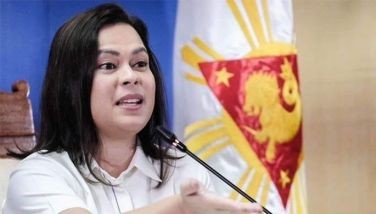Former MNLF warriors wage war vs poverty through aquaculture
January 11, 2004 | 12:00am
BONGAO, Tawi-Tawi – Some 1,000 former Moro National Liberation Front (MNLF) combatants in the town of Panglima Sugala, who have been farming seaweed for several years, are now learning how to cultivate high-value marine finfish to supplement their income.
The former rebels are being introduced to aquaculture farming through a project designed by the Targeted Commodity Expansion Program (TCEP), a component of the USAID-funded Growth with Equity in Mindanao (GEM) program. Project beneficiaries from Barangays Parangan, Balimbing and Buan are now participating in TCEP training sessions.
MNLF state chairman for Tawi-Tawi Damming Hadjirul said the project is a welcome development. "With improved income, many of us can now send our children to school," he stressed.
Hadjirul is among the rebel returnees who were previously assisted by another USAID-funded project, the Livelihood Enhancement and Peace (LEAP) program, which engaged returnees in sustainable rice, corn and seaweed farming, following the signing of a peace agreement between the MNLF and the Philippine Government in 1996.
"We will now have two sources of income. Since cultivating fish does not require too much time, we can still tend our seaweed farms on our normal schedule. The good thing is, both have ready markets," Hadjirul added.
GEM is collaborating with Support Project for the Indigenous Cultural Communities and MNLF in the Zone of Peace within Agrarian Reform Communities (SPICCnZPARC), which is providing production inputs for the project. SPICCnZPARC is a grant component of the International Fund for Agricultural Development-assisted Western Mindanao Community Initiatives Project (WMCIP) of the Department of Agrarian Reform.
"You were once engaged in an armed struggle. This time, let’s wage war against poverty," WMCIP program director Rogelio Borbon told the 20 MNLF cluster heads during the launching of the project. Each cluster has 50 members.
Like the other island-municipalities of Tawi-Tawi, Panglima Sugala is rich in marine resources, making it an ideal place for aquaculture. Fingerlings for marine products abound in the area. Fish pens can be conveniently placed under solar dryers which are strategically located near the seaweed farms.
Aside from improving the beneficiaries’ income, Borbon said the project also indicates that the government is sincere in its efforts to make the former rebels partners in achieving peace and development in the area.
"The project can strengthen people’s confidence in the government’s development efforts," WMCIP’s Borbon said. "We also want to show other foreign donor agencies and investors that enterprise projects can succeed even in the country’s southernmost frontier."
GEM and LEAP programs are implemented in partnership with the Mindanao Economic Development Council (MEDCo).
The former rebels are being introduced to aquaculture farming through a project designed by the Targeted Commodity Expansion Program (TCEP), a component of the USAID-funded Growth with Equity in Mindanao (GEM) program. Project beneficiaries from Barangays Parangan, Balimbing and Buan are now participating in TCEP training sessions.
MNLF state chairman for Tawi-Tawi Damming Hadjirul said the project is a welcome development. "With improved income, many of us can now send our children to school," he stressed.
Hadjirul is among the rebel returnees who were previously assisted by another USAID-funded project, the Livelihood Enhancement and Peace (LEAP) program, which engaged returnees in sustainable rice, corn and seaweed farming, following the signing of a peace agreement between the MNLF and the Philippine Government in 1996.
"We will now have two sources of income. Since cultivating fish does not require too much time, we can still tend our seaweed farms on our normal schedule. The good thing is, both have ready markets," Hadjirul added.
GEM is collaborating with Support Project for the Indigenous Cultural Communities and MNLF in the Zone of Peace within Agrarian Reform Communities (SPICCnZPARC), which is providing production inputs for the project. SPICCnZPARC is a grant component of the International Fund for Agricultural Development-assisted Western Mindanao Community Initiatives Project (WMCIP) of the Department of Agrarian Reform.
"You were once engaged in an armed struggle. This time, let’s wage war against poverty," WMCIP program director Rogelio Borbon told the 20 MNLF cluster heads during the launching of the project. Each cluster has 50 members.
Like the other island-municipalities of Tawi-Tawi, Panglima Sugala is rich in marine resources, making it an ideal place for aquaculture. Fingerlings for marine products abound in the area. Fish pens can be conveniently placed under solar dryers which are strategically located near the seaweed farms.
Aside from improving the beneficiaries’ income, Borbon said the project also indicates that the government is sincere in its efforts to make the former rebels partners in achieving peace and development in the area.
"The project can strengthen people’s confidence in the government’s development efforts," WMCIP’s Borbon said. "We also want to show other foreign donor agencies and investors that enterprise projects can succeed even in the country’s southernmost frontier."
GEM and LEAP programs are implemented in partnership with the Mindanao Economic Development Council (MEDCo).
BrandSpace Articles
<
>
- Latest
Latest
Latest
April 10, 2024 - 5:12pm
By Ian Laqui | April 10, 2024 - 5:12pm
March 4, 2024 - 3:32pm
By Ian Laqui | March 4, 2024 - 3:32pm
March 4, 2024 - 2:12pm
By Kristine Daguno-Bersamina | March 4, 2024 - 2:12pm
February 17, 2024 - 2:31pm
February 17, 2024 - 2:31pm
February 13, 2024 - 7:24pm
By Gaea Katreena Cabico | February 13, 2024 - 7:24pm
Recommended
November 29, 2024 - 12:00am




























